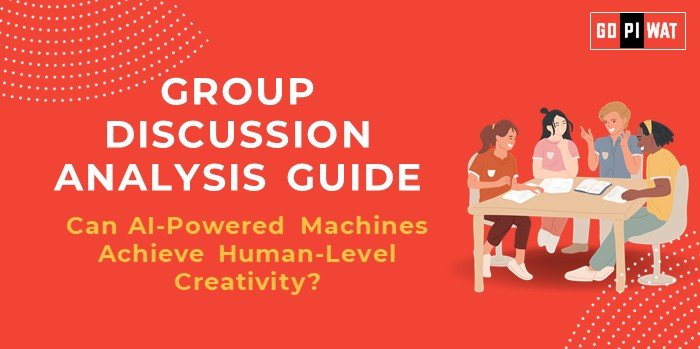📋 Group Discussion (GD) Analysis Guide
🎨 Topic: Can AI-Powered Machines Achieve Human-Level Creativity?
🌐 Introduction
AI-powered machines are redefining innovation, with tools like OpenAI’s DALL-E 3 and advanced generative AI pushing creative boundaries. The debate on whether AI can achieve human-level creativity encompasses technological, ethical, and philosophical dimensions, making it a pertinent topic for B-school discussions.
📊 Quick Facts & Key Statistics
- 📈 Market Growth: The generative AI market is expected to grow from $36.06 billion in 2024 to $356.10 billion by 2030 at a CAGR of 46.47%.
- 🌍 Content Surge: Web searches on AI content increased by 900% since February 2022.
- 🎨 DALL-E 3 and GPT Models: Advanced AI tools like DALL-E 3 create realistic images from text prompts.
- 📜 AI Patents: The rise in AI-related patents showcases global innovation and investment in AI technologies.
🤝 Stakeholders and Their Roles
- 💻 Technology Developers: Innovating and refining AI capabilities (e.g., OpenAI, Google DeepMind).
- 🏛️ Governments and Policy Makers: Establishing regulatory frameworks for ethical AI use.
- 🎭 Creative Professionals: Adapting to the disruption in traditional creative processes.
- 👥 End-Users and Consumers: Benefiting from or critiquing AI-generated works.
🏆 Achievements and Challenges
- Achievements:
- ✅ Scalability: AI generates content like designs and music at unprecedented speed.
- 🌟 Accessibility: Democratizes creativity, enabling non-experts to produce high-quality outputs.
- 🚀 Innovation: Expands creative possibilities through blending art, technology, and imagination.
- Challenges:
- ⚖️ Authenticity Concerns: Critics argue AI lacks originality and emotional depth.
- 📉 Job Market Disruption: Automation threatens traditional creative roles.
- 📜 Ethical Questions: Issues like bias, copyright disputes, and misuse of AI outputs remain unresolved.
🌍 Global Comparisons
- 🇯🇵 Japan: AI is used in manga production to enhance efficiency.
- 🇪🇺 EU: Emphasizes strict copyright policies to protect originality.
🧠 Effective Discussion Approaches
- Opening Approaches:
- 📈 “With generative AI projected to reach $356.10 billion by 2030, how does this reshape the landscape of human creativity?”
- 🎨 “DALL-E 3’s ability to create realistic art raises questions: Is it genuine creativity or algorithmic mimicry?”
- Counter-Argument Handling:
- 🤝 “While AI lacks emotions, it complements human creativity, enabling unique hybrid outputs.”
- 📊 “Bias in AI models can be mitigated with diverse and inclusive training datasets.”
🔍 Strategic Analysis of Strengths and Weaknesses
- ✅ Strengths: High efficiency, democratization of creativity, scalable content generation.
- ⚠️ Weaknesses: Emotional disconnect, dependence on training data, ethical dilemmas.
- 🌟 Opportunities: Hybrid creativity models, integration into business innovations.
- ⚡ Threats: Displacement of creative jobs, intellectual property disputes.
📄 Structured Arguments for Discussion
- ✅ Supporting Stance: “AI is a transformative tool that enhances human creativity by automating repetitive tasks and inspiring innovative solutions.”
- ❌ Opposing Stance: “AI cannot replicate the emotional intelligence and life experiences essential to true creativity.”
- ⚖️ Balanced Perspective: “AI amplifies human creativity but must be complemented by ethical frameworks to achieve meaningful innovation.”
📚 Connecting with B-School Applications
- 💼 Real-World Applications: AI-enhanced branding strategies, product innovation, and operational efficiencies.
- 📝 Sample Interview Questions:
- “Can AI-generated creativity replace human intuition in decision-making?”
- “How can companies ensure ethical use of AI in creative industries?”
- 💡 Insights for Students: Explore hybrid creativity, ethical considerations, and innovative applications for AI in business.


